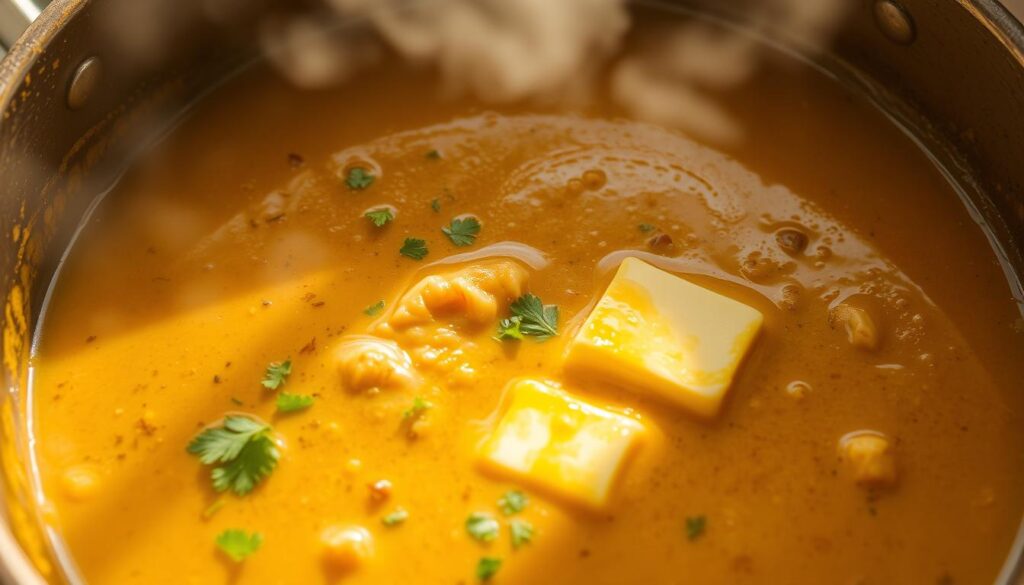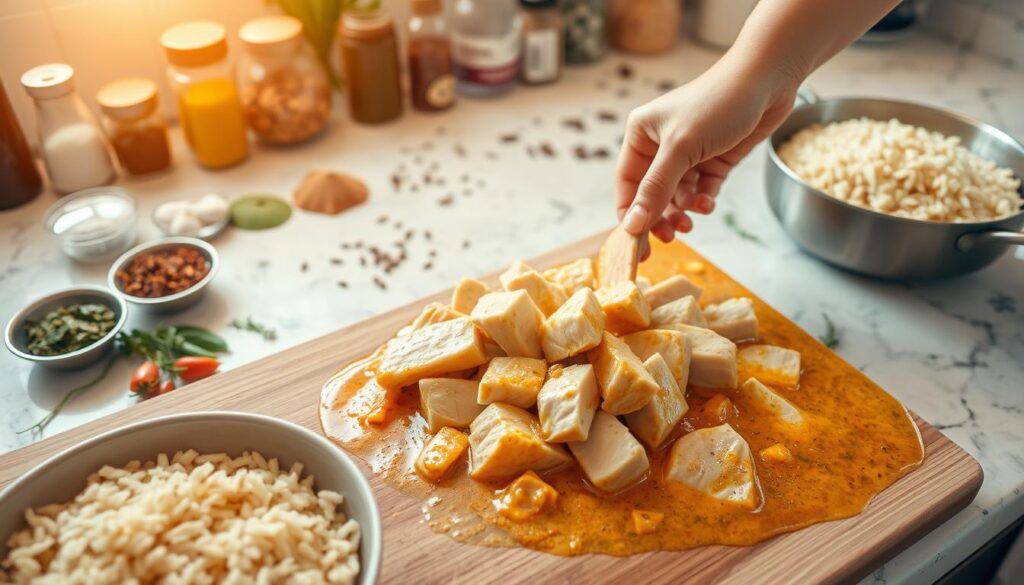Butter chicken is a globally loved dish known for its creamy texture and mild spices. This Indian classic often surpasses restaurant quality when made at home. Unlike Chicken Tikka Masala, it uses a butter base instead of oil, creating a smoother and richer flavor.
Our recipe stays authentic by incorporating tandoori-style grilled chicken, adapted for home kitchens. For the best results, marinate the chicken for over 12 hours. This ensures optimal flavor and tenderness.
The dish combines yogurt-marinated chicken with an aromatic spice blend and a silky tomato-cashew sauce. With simple ingredients and a bit of time, you can recreate this restaurant favorite in your own kitchen.
Key Takeaways
- Butter chicken is a creamy, mildly spiced dish loved worldwide.
- It differs from Chicken Tikka Masala with its butter base and smoother texture.
- Marinate the chicken for 12+ hours for the best flavor and tenderness.
- The recipe uses yogurt-marinated chicken and a tomato-cashew sauce.
- Authentic tandoori-style grilled chicken is adapted for home kitchens.
Introduction to Butter Chicken
Murgh Makhani, a beloved Indian curry, has a rich history rooted in Delhi’s culinary scene. This iconic dish was created by Kundan Lal Gujral at the famous Moti Mahal restaurant. Originally, it was a clever way to use leftover tandoori chicken, transforming it into a creamy, flavorful masterpiece.
The name “makhani” refers to its buttery texture, achieved by blending cream and clarified butter. Traditional recipes use bone-in chicken marinated for up to 48 hours in hung curd, ensuring maximum tenderness. Signature ingredients like kasuri methi (dried fenugreek) and Kashmiri chili add depth and vibrant color to the curry.
Authentic versions of this dish differ slightly from modern adaptations. While the original recipe focuses on simplicity, some variations include onions for added flavor. However, the USDA recommends marinating poultry for no more than 48 hours to ensure safety and quality.
“Murgh Makhani is more than just a dish; it’s a celebration of Indian culinary ingenuity.”
With over 8.8K social shares, this recipe continues to win hearts globally. Whether you’re cooking at home or enjoying it at a restaurant, this Indian classic promises a rich and satisfying experience.
Ingredients You’ll Need
To create this iconic dish, you’ll need a carefully curated list of ingredients. Each component plays a vital role in achieving the rich, authentic flavors that make this recipe stand out. Let’s break it down into two parts: the marinade and the sauce.
For the Chicken Marinade
The chicken marinade is the foundation of this dish. Start with 500g of boneless thighs for the best texture. Combine Greek yogurt, lemon juice, and a 6-spice blend. This includes garam masala, cumin, turmeric, and Kashmiri chili for color and heat. For a balanced flavor, add 1 tbsp Kashmiri chili and ½ tsp cayenne.
For the Butter Chicken Sauce
The sauce is where the magic happens. Use 28 cashews (42g) for a creamy base or substitute with heavy cream. Mutti brand tomato products are recommended for consistent results. Add garam masala and a pinch of powder to enhance the flavor. For a nut-free version, use ¼ cup almond flour mixed with water.
Pro tip: Freshness of spices, especially garam masala, significantly impacts the dish’s intensity. Double-check the quality of your ingredients for the best results.
Marinating the Chicken
The secret to tender, flavorful meat lies in the marinating process. Start with a 20-minute acid bath using lemon juice and salt. This step helps break down proteins, ensuring the meat absorbs the spices fully.
Next, apply the second marinade, which includes yogurt and a blend of spices. For the best results, let the marinated chicken sit for at least 12 hours. This allows enzymes to work, enhancing both texture and taste.
Always use glass or ceramic containers to refrigerate the meat. Metal can react with acidic ingredients, altering the flavor. For a pro tip, pat the chicken dry before marinating to ensure the spices stick better.
If you’re short on time, freeze the marinated chicken for up to two weeks. Just thaw it in the fridge before cooking. Avoid skipping the step of straining the yogurt, as it prevents a watery sauce and maintains the dish’s rich consistency.
Cooking the Butter Chicken Sauce
The sauce is the heart of this dish, bringing together rich flavors and creamy textures. Start by sautéing 130g of onions in a pan until golden. This simple trick reduces the acidity of canned tomatoes, creating a balanced base.
Next, blend soaked cashews with the tomatoes for a smooth puree. High-speed blenders work best, but soaking the cashews ensures a silky consistency. Add this mixture to the sautéed onions, along with whole spices like cinnamon and cardamom.

Layer the flavors by cooking the aromatics first, then adding the tomato-cashew puree. Maintain medium heat to prevent burning and allow the spices to infuse. Simmer for 15 minutes until the oil separates, signaling a well-developed flavor.
For a restaurant-quality finish, strain the sauce through a mesh sieve. This step ensures a smooth, lump-free texture. If you’re short on time, the sauce base can be refrigerated for up to three days, making it a convenient make-ahead option.
“A great sauce is the foundation of any memorable dish.”
With these tips, you’ll master the art of cooking the perfect butter chicken sauce. Whether you’re serving it immediately or saving it for later, this sauce guarantees a flavorful experience.
Grilling the Marinated Chicken
Grilling the marinated chicken is the step that brings out its smoky, tender perfection. Whether you’re using an oven or a pan, the goal is to achieve a golden, caramelized crust while keeping the inside juicy.
For the oven method, preheat to 460°F (240°C). Place the chicken pieces on a baking tray and roast for 20-22 minutes. This high heat ensures a crispy exterior without drying out the meat.
If using a pan, heat 1 tbsp of oil or ghee over medium heat. A cast iron skillet works best for even browning. Cook the chicken pieces in batches to avoid overcrowding, which can lead to uneven charring.
To test for doneness, use a meat thermometer. The internal temperature should reach 165°F. For a pro tip, finish the chicken under high heat for a few minutes to enhance the caramelized crust.
Thighs are more forgiving than breasts, which can dry out if overcooked. If you’re short on time, the oven method is efficient, while the pan method offers more control over browning.
Assembling the Butter Chicken
Bringing the dish together is the final step to achieving its signature richness. Start by adding the grilled meat to the sauce when it reaches 180°F. This ensures the flavors meld perfectly without overcooking the protein.
To adjust the consistency, incorporate ½ cup of hot water as needed. This step helps maintain the ideal texture, especially if the sauce thickens too much during the cooking process.

Balance the flavors by adding 1 tsp of sugar to counteract the natural acidity of the tomatoes. This subtle addition enhances the overall taste without overpowering the dish.
For a final touch, crush ½ tbsp of kasuri methi between your palms and sprinkle it into the sauce. This dried fenugreek adds a unique aroma and depth to the dish.
Incorporate the cream using the tempering method to prevent curdling. Slowly add it while stirring continuously. This technique ensures a smooth, velvety texture.
Finish with a swirl of extra butter just before serving. This not only enhances the richness but also activates the fat-soluble spices in the cream, intensifying the flavors.
Serving Suggestions
Elevate your meal with these perfect pairings for a rich and flavorful dish. Start with jeera rice, a fragrant basmati option infused with cumin seeds. Its light texture balances the creamy sauce beautifully. For a twist, try jasmine rice, which offers a slightly stickier consistency.
No Indian meal is complete without bread. Garlic naan is a classic choice, offering a soft and chewy texture that soaks up the sauce. Alternatively, roti or paratha can be used for a thinner, less absorbent option.
Add a fresh touch with kachumber salad, a mix of cucumbers, tomatoes, and onions. This crunchy side dish provides a refreshing contrast to the richness of the main course. For presentation, drizzle a swirl of cream on top and garnish with cilantro sprigs.
Pair your meal with an off-dry Riesling. Its slight sweetness balances the dish’s spices perfectly. For leftovers, reheat with a splash of milk to restore the sauce’s creamy texture. If you’re dairy-free, substitute coconut milk for a lighter, equally delicious version.
“The right pairing can transform a meal into an unforgettable experience.”
Serve in a wide bowl to showcase the vibrant colors and textures. These suggestions ensure every bite is a harmonious blend of flavors and textures.
Conclusion
Creating the best butter chicken at home is easier than you think. Focus on marinating the meat for at least 12 hours and straining the sauce for a silky texture. These steps ensure a flavorful and tender result every time.
Feel free to experiment with the spice levels to suit your taste. Adjust the chili to make it mild or fiery, depending on your preference. This flexibility makes the recipe perfect for everyone.
Store leftovers in the fridge for up to three days or freeze for three months. This saves time and lets you enjoy the dish whenever you crave it. Share your creations using #ButterChickenJourney to inspire others.
For a pro tip, double the sauce batch and freeze it. This makes future meals quicker and just as delicious. Whether it’s a cozy dinner or a family gathering, this recipe is sure to impress.
